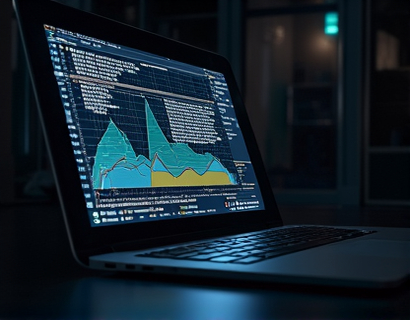Revolutionizing Token Management: Harnessing Smart-Contract Innovation for UCASH and U Asset Tokenization
The landscape of digital asset management is undergoing a transformative shift, driven by the integration of smart-contract technology. This evolution offers unprecedented opportunities for enhancing security, efficiency, and performance in managing tokens pegged to leading cryptocurrencies and digital assets. By leveraging advanced smart-contract solutions, individuals and organizations can revolutionize their financial ecosystems, ensuring robust and reliable token management.
Tokenization, the process of converting rights to an asset into a digital token on a blockchain, has gained significant traction in recent years. This technology enables the creation of tokens that represent a wide range of assets, from real estate and commodities to cryptocurrencies and utility tokens. The use of smart contracts in this process is pivotal, as they automate and enforce the rules governing token creation, distribution, and management.
Understanding Smart Contracts in Token Management
Smart contracts are self-executing contracts with the terms of the agreement directly written into code. They run on blockchain networks, ensuring transparency, immutability, and security. In the context of token management, smart contracts serve as the backbone, automating various processes such as token issuance, trading, and redemption.
For instance, when a token is created, a smart contract can be programmed to automatically allocate a specific amount of the underlying asset to each token holder. This ensures that the token's value remains pegged to the asset, maintaining stability and trust in the system. Additionally, smart contracts can handle complex operations like dividend distributions, staking mechanisms, and liquidation processes, all with minimal human intervention.
Enhancing Security through Smart Contracts
Security is a paramount concern in digital asset management. Traditional token management systems often rely on centralized authorities, making them vulnerable to hacks, fraud, and operational failures. Smart contracts, by their nature, are decentralized and tamper-proof, significantly reducing these risks.
Each transaction recorded on the blockchain is cryptographically secured and verified by network participants, ensuring that once a transaction is confirmed, it cannot be altered. This level of security is crucial for token management, especially when dealing with valuable assets. Moreover, smart contracts can include built-in security features such as access controls, audit trails, and emergency shutdown mechanisms, further bolstering the overall security posture.
Efficiency and Automation in Token Operations
One of the most significant advantages of using smart contracts in token management is the automation of repetitive and time-consuming tasks. Manual processes, such as token issuance and transfer verification, can be error-prone and slow. Smart contracts eliminate these inefficiencies by executing operations instantly and accurately.
For example, when a user wants to buy tokens, a smart contract can automatically deduct the required amount of cryptocurrency from the user's wallet, create the corresponding number of tokens, and transfer them to the user's wallet. This seamless process not only speeds up transactions but also reduces the potential for human error and fraud.
Pegging Tokens to Leading Cryptocurrencies and Digital Assets
Token pegging involves fixing the value of a token to that of a stable cryptocurrency or digital asset, such as UCASH. This mechanism helps maintain price stability and trust among users. Smart contracts play a crucial role in implementing and maintaining these pegs.
To peg a token to UCASH, for instance, a smart contract can be designed to lock a predetermined amount of UCASH for each token issued. This ensures that the token's value remains stable, as any fluctuations in the UCASH price are directly reflected in the token's value. The smart contract continuously monitors the UCASH price and adjusts the token's value accordingly, maintaining the peg.
This approach not only provides users with a stable store of value but also attracts investors who prefer assets with predictable and stable prices. The automation provided by smart contracts ensures that the peg is maintained at all times, without the need for manual intervention.
Benefits of Smart-Contract-Based Token Management
The integration of smart contracts in token management offers numerous benefits that traditional systems cannot match.
- Enhanced Security: Decentralized and immutable transactions reduce the risk of hacks and fraud.
- Increased Efficiency: Automated processes speed up operations and reduce manual errors.
- Transparency: All transactions are recorded on the blockchain, providing a clear and verifiable audit trail.
- Cost Reduction: Elimination of intermediaries lowers transaction costs.
- Flexibility: Smart contracts can be customized to meet specific needs, from simple token issuance to complex governance models.
Case Study: Tokenization of UCASH
To illustrate the practical application of smart-contract innovation in token management, consider the tokenization of UCASH. UCASH, a stablecoin, can be tokenized to create UCASH tokens, which are pegged to the value of UCASH.
The smart contract for this tokenization process would include several key functions:
- Token Issuance: When a user deposits UCASH into the system, the smart contract creates a corresponding number of UCASH tokens and transfers them to the user's wallet.
- Value Maintenance: The smart contract continuously monitors the UCASH price and adjusts the token's value to maintain the peg.
- Redemption: Users can redeem their UCASH tokens for UCASH cryptocurrency, ensuring a seamless and secure transaction.
- Governance: The smart contract can include rules for token burning or additional issuance based on predefined conditions, such as network activity or community votes.
This tokenization not only provides users with a stable and secure asset but also opens up new possibilities for decentralized finance (DeFi) applications, such as lending, staking, and yield farming.
Future Prospects and Challenges
The future of token management through smart contracts is promising, with ongoing advancements in blockchain technology and smart-contract development. However, several challenges need to be addressed to fully realize the potential of this technology.
First, regulatory clarity is essential. As tokenization and DeFi gain traction, regulators are beginning to take notice, and clear guidelines are needed to ensure compliance and protect users. Second, interoperability between different blockchain platforms is crucial for widespread adoption. Standardization efforts can help create a more connected and efficient ecosystem.
Technical challenges, such as scalability and gas fees on crowded networks, also need to be addressed. Innovations like layer 2 solutions and cross-chain bridges can help mitigate these issues, making token management more accessible and cost-effective.
Conclusion
The integration of smart-contract technology in token management represents a significant leap forward in digital asset management. By leveraging the power of blockchain and smart contracts, users can enjoy enhanced security, efficiency, and flexibility in managing their tokens pegged to leading cryptocurrencies and digital assets.
As the technology matures and adoption grows, the financial ecosystem will become more robust, transparent, and user-friendly. Embracing these innovations is essential for anyone looking to stay ahead in the evolving world of digital assets.










































